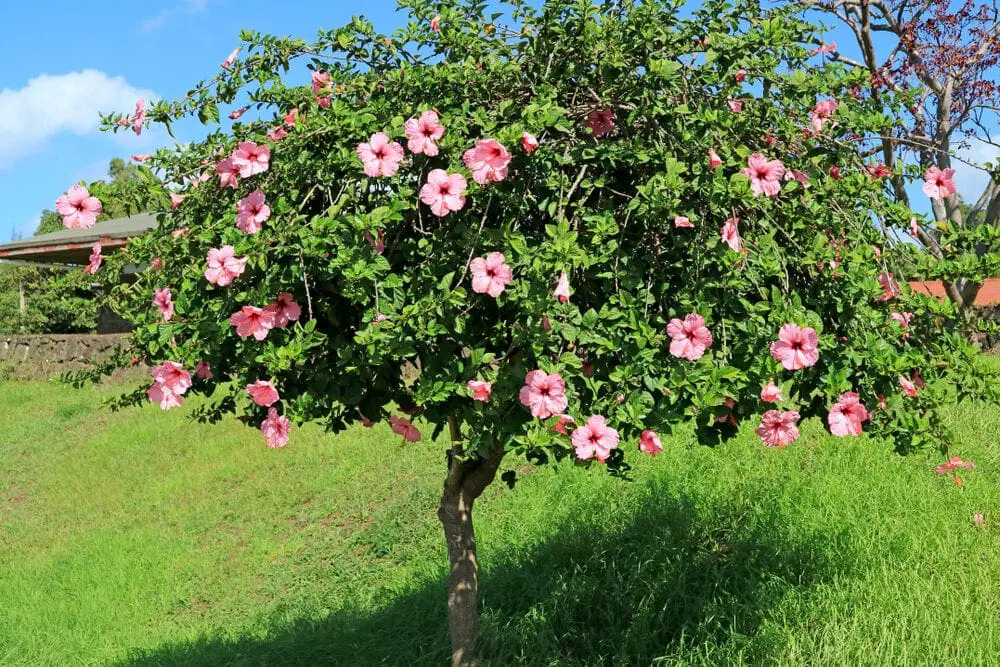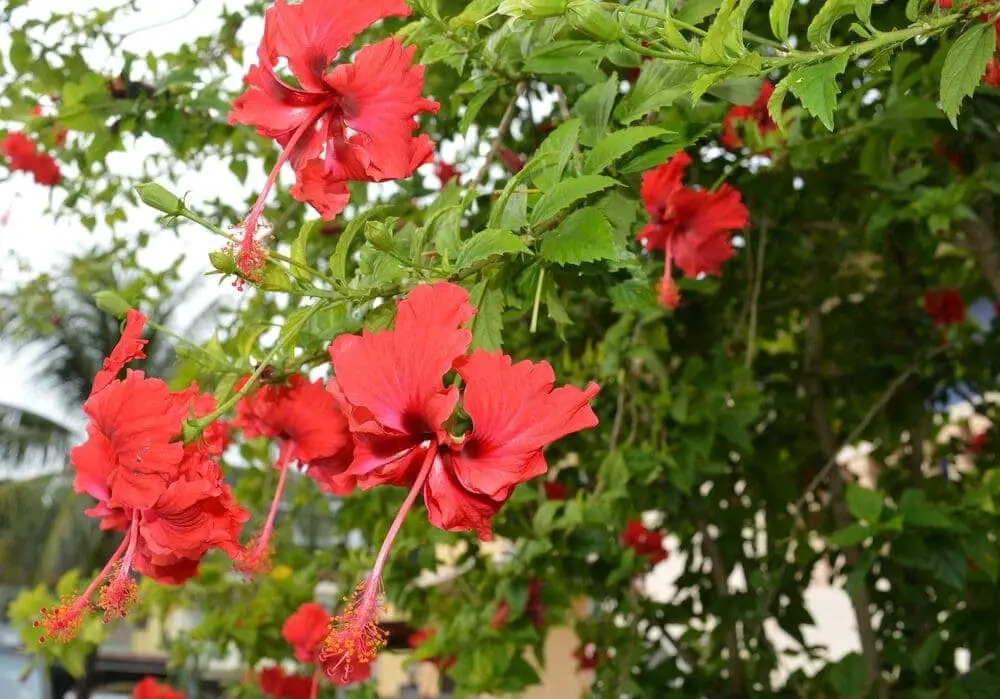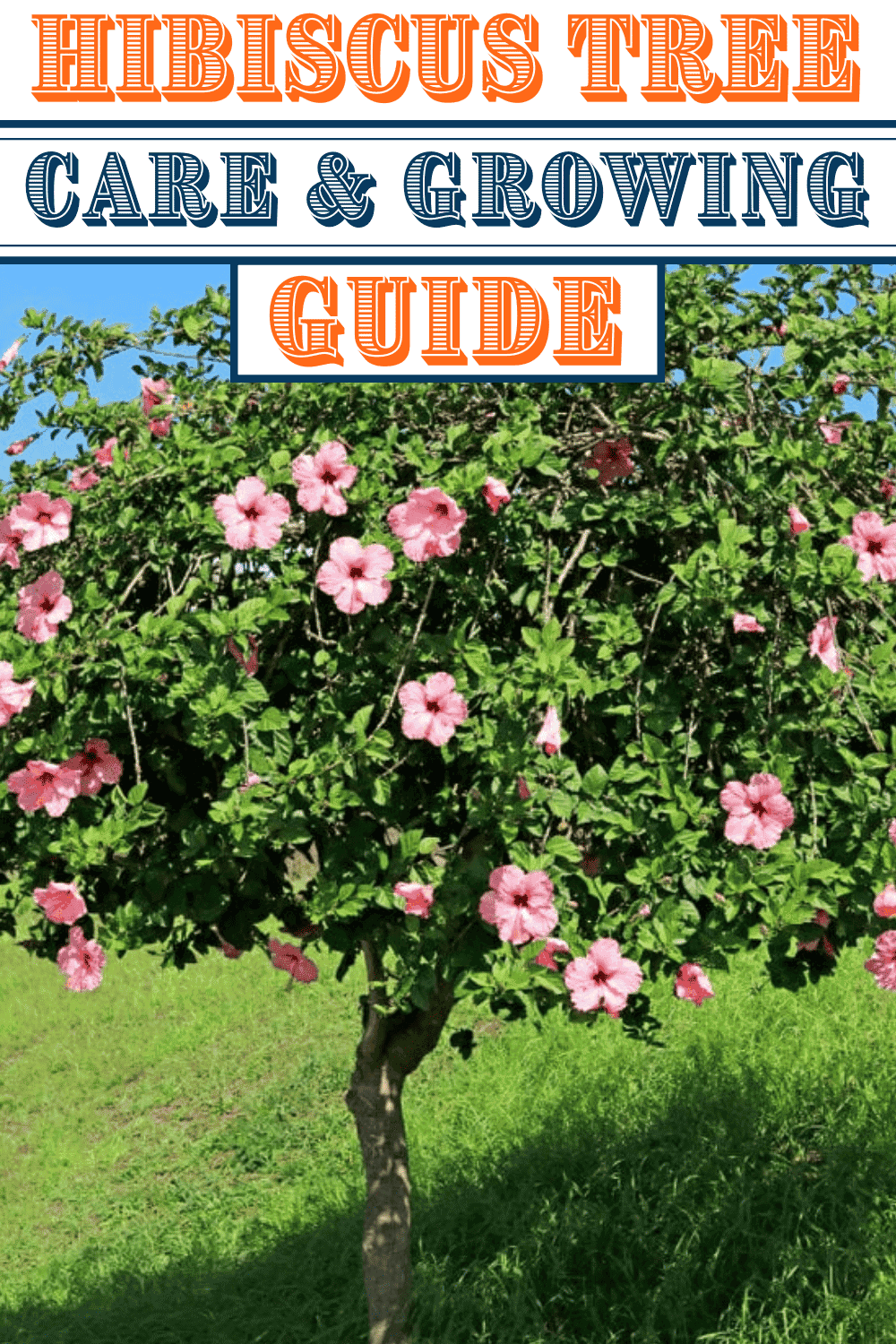Growing a Hibiscus tree in your garden is a great way to add a tropical flare.
Planting them will give you many years of beautiful flowers. Some prefer to grow them in planters so they can move them around the house when they want to.
When you grow them in a container, they like a cozy fit, which means slightly root-bound.
Hibiscus Tree Care & Growing Guide
1. Light Requirement
The optimal light for a Hibiscus tree would be in a location that gets direct sunlight for five to six hours each day. You can grow them in partial shade but there will not be as many blooms produced.
2. Water
During a Hibiscus tree blooming stage, they will need a large amount of water. In warm weather, they will need to be watered each day. As the temperatures cool, it does not need a lot of water. If it gets too much water, you can kill the plant. During the winter, you will only need to water it when the soil is dry to the touch. When watering the Hibiscus tree, use warm water instead of cold water.
Because the Hibiscus tree needs a lot of nutrients in order to bloom, you should use a high potassium fertilizer in the summer. You can use a slow-release once a month, or a diluted liquid fertilizer once a week. You can also add high potassium compost to the soil. No fertilizer is needed at all during the winter.
3. Climate
The USDA Hardiness Zone should be 9 to 11.
4. Soil
The best soil for a Hibiscus tree would be neutral to slightly acidic. If your garden soil is not very acidic, you can add some peat moss to the soil. Many times, when putting the Hibiscus tree in a planter, you can use a sandy or soilless potting mix. This type helps to promote drainage and prevent compaction of the roots.

5. Temperature
This is a plant that flowers best in temperatures between 60-90 degrees Fahrenheit. The Hibiscus tree cannot tolerate temperatures below 32 degrees Fahrenheit. If you have them growing outdoors, you will need to bring them inside when the temperature gets near freezing.
It is considered an evergreen so when the temperatures go below 50 degrees Fahrenheit, it becomes deciduous, which means it sheds its leaves each year. If it dies down to the ground, it will re-sprout if the ground does not freeze.
6. Repotting
If you want to repot your Hibiscus tree, you can do it using a softwood cutting, which is a branch on an existing plant that has not matured. Make sure that the cutting is four to six inches long and have leaves at the bottom. Put the cutting in soil that drains well and keep the soil moist until it roots.
7. Speed of Growth
It can take two to three years to reach a height of 15 feet so it grows quite rapidly.
8. Height and Spread
The height of the Hibiscus tree can be as high as 15 feet with flowers up to six inches in diameter.
9. Flowers
The flowers bloom in the fall and summer. They range in colors from white, red, pink, and multicolor. They are huge, hollyhock-like flowers in a disc-shape and range in size from 6-12 inches across. Indoors, they can bloom all year long.
10. Trimming
The Hibiscus tree does not need to be trimmed but if you want, you can trim it to help rejuvenate the look. The trimming should be done in early spring to help stimulate the budding process. It will also help the plant thrive during the summer months. If you do trim it later in the season make sure that you do not trim the branches too far back. Doing so will hinder the blooming process.

Is Hibiscus Tree Poisonous?
The plant and blossoms are non-toxic to humans and often the flowers are used for medicinal purposes or used to make tea. In some individuals, they may have an allergic reaction or skin irritation if they come in contact with the Hibiscus tree. They are poisonous to pets and if ingested, can cause serious adverse effects.
Can Hibiscus Tree grow in Water?
No, they cannot be grown in water.
How to get Hibiscus Tree to Flower?
To help encourage your Hibiscus tree to bloom again, you need to remove all the old flowers before they form seed heads. You can also prune the plants back by one-third after the blooms are finished. In early spring, you should remove the dead stems from your established plants. Once this is done, apply a balanced fertilizer.
Common Plant Diseases
Hibiscus tree is prone to a variety of diseases, including:
- Japanese beetles—they eat leaves until only veins remain. To get rid of them you can use row covers on your plants or just pick them off, which is the most effective way.
- Aphids—these can cause leaves that are yellow, or misshapen. You can spray the leaves with cold water to dislodge them, dust the plants with flour, or wiping the leaves with a soapy water mixture every couple of days for two weeks.
- Whiteflies—they suck out the plant juices, leaving behind a sticky substance. The leaves will turn yellow or pale, wilt, and cause stunted growth. One way to get rid of them is to blast the leaves with cold water in the morning. You can also use a soapy mixture to spray the plant.
- Yellow leaves—this usually happens if you give the Hibiscus plant too much water during the winter months.
- A burnt looking leaf—this happens if you use too much fertilizer or it is too strong.
More like this: Bottlebrush Tree Care & Growing Guide
Conclusion
- The Hibiscus tree is considered a shrub
- When planting, they should be stared indoors 12 weeks before the last frost. Soak seeds in warm water an hour before planting. If you want to plant them outdoors, plant the seeds after the last frost
- Plant them where they are not exposed to high winds so the long stems do not break.
- Space the plants 2-3 feet apart.
- The Hibiscus tree’s colorful blooms attract butterflies and hummingbirds.

Victoria is the owner and main author of hobby plants. She loves spending her free time in her garden planting and taking care of her plants. Victoria hopes you enjoy the content here!
![How Do You Propagate a Money Tree? [COMPLETE GUIDE] How Do You Propagate a Money Tree? [COMPLETE GUIDE]](https://www.hobbyplants.com/wp-content/uploads/2022/06/how-to-propagate-money-tree-300x158.jpg)
![Best Soil For A Money Tree? [DIFFERENCES EXPLAINED] Best Soil For A Money Tree? [DIFFERENCES EXPLAINED]](https://www.hobbyplants.com/wp-content/uploads/2022/08/best-soil-for-money-tree-300x158.jpg)
![Mother Of Thousands Plant [Complete Plant Care Guide] Mother Of Thousands Plant [Complete Plant Care Guide]](https://www.hobbyplants.com/wp-content/uploads/2022/07/mother-of-thousands-plant-300x158.jpg)
![How Often Should You Water Pothos? [Complete Care Guide] How Often Should You Water Pothos? [Complete Care Guide]](https://www.hobbyplants.com/wp-content/uploads/2022/07/how-often-to-water-pothos-300x158.jpg)
![Can Snake Plants Live Outside? [COMPLETE CARE GUIDE] Can Snake Plants Live Outside? [COMPLETE CARE GUIDE]](https://www.hobbyplants.com/wp-content/uploads/2022/08/can-snake-plants-live-outside-300x158.jpg)
![Majesty Palm Plant Care: [Complete Beginner's Guide] Majesty Palm Plant Care: [Complete Beginner's Guide]](https://www.hobbyplants.com/wp-content/uploads/2022/08/majesty-palm-care-300x158.jpg)
![Exotic Angel Plant Care: [Complete Beginner's Guide] Exotic Angel Plant Care: [Complete Beginner's Guide]](https://www.hobbyplants.com/wp-content/uploads/2022/08/exotic-angel-plant-care-300x158.jpg)
![Do Coleus Like Sun Or Shade: [Complete Care Guide] Do Coleus Like Sun Or Shade: [Complete Care Guide]](https://www.hobbyplants.com/wp-content/uploads/2022/08/coleus-sun-or-shade-300x158.jpg)
![Snow White Waffle Plant: [Complete Care Guide] Snow White Waffle Plant: [Complete Care Guide]](https://www.hobbyplants.com/wp-content/uploads/2022/08/snow-white-waffle-plant-300x158.jpg)
![Waffle Plant Care: [Complete Beginner's Guide] Waffle Plant Care: [Complete Beginner's Guide]](https://www.hobbyplants.com/wp-content/uploads/2022/08/waffle-plant-300x158.jpg)
![Bird Of Paradise Plant Care: [Complete Beginner's Guide] Bird Of Paradise Plant Care: [Complete Beginner's Guide]](https://www.hobbyplants.com/wp-content/uploads/2022/08/bird-of-paradise-plant-300x158.jpg)
![Purple Passion Plant Care: [Complete Beginner's Guide] Purple Passion Plant Care: [Complete Beginner's Guide]](https://www.hobbyplants.com/wp-content/uploads/2022/08/purple-passion-plant-care-300x158.jpg)